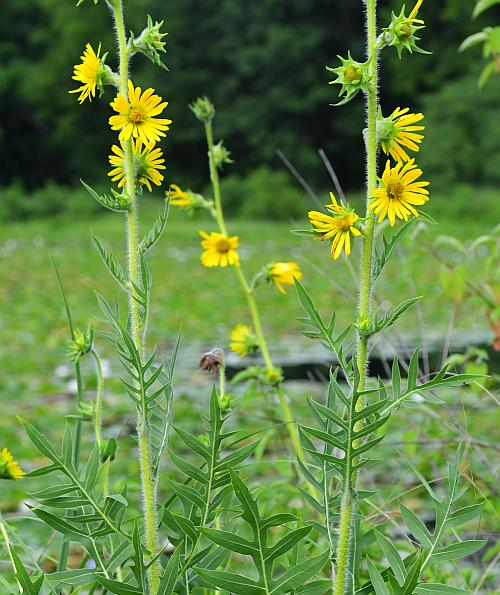Silphium laciniatum L.
Compass Plant

Native
CC = 6
CW = 5
MOC = 53
© SRTurner
Silphium laciniatum L.Compass Plant | |
 |
Native CC = 6 CW = 5 MOC = 53 |
© SRTurner |
|
Family - Asteraceae/Heliantheae Habit - Perennial forb with woody taproots. Stem - Erect, to 2.5 m, usually solitary, circular in cross section, stout, moderately roughened and pubescent with long, slender, pustular-based hairs, often also with minute, spreading hairs, some of these usually gland-tipped.
Leaves - Alternate and basal, thick, leathery, roughened with slender, spreading, pustular-based hairs, often also dotted with scattered, sessile to impressed glands. Basal leaves present at flowering, long-petiolate, the blade 30-60 cm long, ovate in outline, 1 time or more commonly 2 times pinnately deeply lobed or divided, the lobes or divisions mostly sharply pointed at the tip, broadly attached at the base, the margins otherwise entire or few-toothed and with minute, appressed hairs. Stem leaves progressively reduced from the stem base, the lowermost leaves similar to the basal leaves, the uppermost leaves 4-15 cm long, mostly short-petiolate to nearly sessile, the blade 1 time pinnately lobed.
Inflorescences - Racemes or narrow, racemelike, short-branched panicles, the heads short-stalked to nearly sessile. Heads - Involucral bracts 25-45, 20-40 mm long, ovate, often spreading or recurved at the sharply pointed tip, the outer surface sparsely to densely hairy and usually also glandular, the margins with a conspicuous fringe of dense, spreading hairs. Receptacle 2-3 cm in diameter.
Flowers - Ray florets 20-35, pistillate, the corolla 20-50 mm long, yellow, showy. Disc florets numerous, staminate, the corolla 6-7 mm long, yellow, usually extending beyond the tips of the chaffy bracts. Style branches with the sterile tip somewhat elongate and tapered. Pappus absent or that of the ray florets of 2 short, triangular, awnlike extensions of the winged angles of the fruit 1-5 mm long (the tip of the fruit then appearing deeply notched), persistent at fruiting.
Fruits - Achenes, 8-14 mm long, obovate in outline, strongly flattened, the surface smooth, glabrous, brown to black, gland-dotted, the angles with relatively broad, slightly lighter wings, each wing incurved and abruptly angled at the tip, the fruit with a relatively deep, sometimes narrowly U-shaped to nearly square apical notch. Flowering - July - September. Habitat - Glades, upland prairies, savannas, dry forest openings, railroads, roadsides. Origin - Native to the U.S. Lookalikes - Broadly, other species of Silphium, also Helianthus spp. Other info. - This tall and unmistakable species is common across much of Missouri, except for parts of the southeastern quadrant of the state where it is uncommon or absent. Its North American range largely comprises a well-defined patch in the American Midwest. Photographs taken at Shaw Nature Reserve, Franklin County, MO, 06-18-2006, 07-15-2006, 07-18-2018, 8-3-2018, and 7-22-2020, and in Weldon Spring Conservation Area, St. Charles County, MO, 7-6-2007 and 7-27-2009 (SRTurner). |